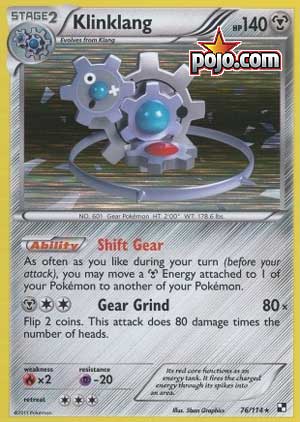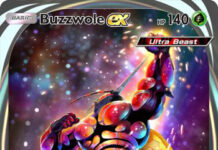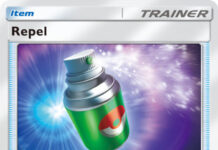
Klinklang – Black & White
Date Reviewed: February 11, 2021
Ratings Summary:
Standard: N/A
Expanded: 1.00
Legacy: 2.50
Ratings are based on a 1 to 5 scale. 1 is horrible. 3 is average. 5 is great.
Reviews Below:

Vince
This throwback is not only going to be about Klinklang from Black & White, but also several other Pokémon that does the same thing albeit different types. This effect of moving energy around originates from Venusaur in Base Set. Around the time I started playing the TCG around 2009, I remember some of the “energy trans” users, including, but not limited to:
-Sceptile DP Stormfront
-Meganium Prime
-Blastoise HS Unleashed/Quagsire SM Dragon Majesty (although they only move energies to your Active Pokemon)
-Klinklang BW (today’s throwback)
-Hydreigon BW Dragons Exalted (was awesome back in the day. Was 2nd best card of Dragons Exalted)
-Aromatisse XY (A Stage 2 ability on a Stage 1? Yeah, this will see play.)
-Golduck BREAK
-Lunala-GX Sun & Moon
-Weavile-GX
-an upcoming Bronzong card from the Sword & Shield series.
Sure, moving energies around won’t help you advance further, just only moving around what’s already there. However, some of the energy trans users worked in conjunction with other Pokémon. Take Hydreigon for example, if you have Hydreigon, Darkrai-EX, and Keldeo-EX, then not only you get to move Dark energies around, you can make Keldeo-EX become your Active Pokemon via Rush In, move one Dark energy to Keldeo-EX, retreat for free via Darkrai-EX’s Dark Cloak, have another Dark attacker in front and move the same energies to it. Regardless of type, the potent trick that can prolong the game is if you moved all the energies away from a heavily damaged Pokémon, flush all of them away with Max Potion, and then move all the energies back to it. The “energy trans” strategy occasionally see competitive success, but probably not on a higher level. If a deck heavily relies on moving energies around, and the opponent has a Garbodor shutting down abilities, then there’s almost nothing you can do.
A future Bronzong card from possibly Battle Styles is going to utterly outclass Klinklang due to being a Stage 1 as opposed to a Stage 2 – much like how Weavile-GX is efficient to use than Hydreigon DRX – which saves deck space tremendously. And you have another Bronzong card from XY Phantom Forces to recover Metal Energies alongside Metal Saucer. Seems like there’s no consequence of discarding Metal energies as fodder because you can not only get those energies back, but you can also manage them. The four-per-name might be an issue for Bronzong for Expanded, though.
Ratings:
Standard: N/A
Expanded: 1/5 (If Bronzong wasn’t there it would have been decent.)
Legacy: 2/5 (good ability, but the amount of Metal support in the Legacy format is slim to none, other than being able to move Special Metal Energy and Blend Energy WLFM around.)
Klinklang has been reviewed once almost ten years ago (https://www.pojo.com/COTD/2011/June/24.shtml) and it arrived at a bad time where fire decks such as Reshiram (usually paired with Typhlosion Prime or Emboar) and Zekrom (ZPST) were some of the best single prize decks at the time that can dish out a lot of damage that’s enough to OHKO around 90% of the entire card pool before EX Pokemon showed up. Bad matchups and Ability denial aside, Klinklang – and maybe a couple other “energy trans” users – would have been a slightly better card as time moved on due to ever increasing card pool. The minimal score that I gave now is because another new card has taken its place. If Bronzong wasn’t present, I would have given this a 2.5 out of 5 or maybe even a 3 out of 5.
Edit 1: left out the Fairy equivalent, added.

Otaku
Today’s Throwback is also a look forward. Not because of a card being reprinted, but an Ability being reused. If not in terms of exact wording, in terms of end results. Today we look at Klinklang (Black & White 76/114), with its familiar Ability “Shift Gear”. Shift Gear lets you move Metal Energy around on your side of the field, from one of your Pokémon to another. It works for any Energy that currently provides [M] while the Ability is being used, so you can move:
- Basic Metal Energy cards
- Special Energy cards that provide only [M], like Coating [M] Energy and Shield Energy
- Special Energy cards that provide multiple types at once, so long as at least one of those types is [M], such as Blend Energy [W][L][F][M], and Unit Energy [L][P][M]
- Special Energy that provide all types at once, such as Aurora Energy and Rainbow Energy
unless a card effect (their own or another card’s) causes them to not provide [M] while attached. This can be trickier than it sounds, as there are some Special Energy cards that provide different types of Energy depending on the circumstances, such as Counter Energy or Prism Energy. You may only move one Energy at a time, unless you’re dealing with a card that provides more than one unit of Energy at a time (like Counter Energy). This isn’t usually a problem, as you may use Shift Gear as many times per turn as you wish, so long as you don’t appear to be wasting time.
We typically refer to these kids of effects as “Energy Transferring” or “Energy Trans” because the original example was named just that. Venusuar (Base Set 15/102; Base Set 2 18/130; Legendary Collection 18/110) has a Pokémon Power named “Energy Trans”; Pokémon Powers are not Abilities, but they work in a similar fashion. Beyond the mechanical differences between Abilities and Pokémon Powers, including most Pokémon Powers turning themselves off when the Pokémon sporting them is afflicted with a Special Condition, the only difference between Shift Gear and Energy Trans is that the former works with [M] Energy and the latter with [G]. There have been Pokémon with this kind of effect between the two, and since the release of Shift Gear…
…which means we know how to use this kind of effect well. At worst, it means you don’t have to worry about Energy committed to a Pokémon, provided you can move it off before that Pokémon is KO’d. Other forms of Energy acceleration, including Energy retention, are welcome additions to Energy transferring decks. Bounce, and forms of healing that discard your Energy (but still work if you have no Energy attached) also work great with these kinds of effects. Move the Energy off of your injured attacker, heal it with Max Potion, then move the Energy back onto it and resume attacking. Another power play, and this is pretty obvious given the cards I listed earlier, is combining Energy transferring effects with compatible Special Energy cards. Whether this means slowly accumulating four Shield Energy to wall well, or getting the various cards that provide multiple Energy types onto the field, so you can cover any single Energy cost, double Energy cost, triple Energy cost, etc. in a single go.
Klinklang is not a Pokémon-EX, or any other specialty mechanic; it is a baseline Pokémon worth only a single Prized when KO’d. It is a Metal type; when Klinklang first released, Fairy types were not a thing, not even rolled into another type; even in the video games, Fairy types weren’t Fairy types pre-Gen VI. The only Metal Weak Pokémon were some of the TCG Water types based on VG Ice-types. Metal Resistance was rare or absent at the time as well, as the designers go back and forth about giving it to Lightning types in the TCG. Good Metal support was mostly limited to Klinklang itself, though there were a few additional options by the time the BW-era ended, with more joining it in the XY series, Sun & Moon series, and (of course) now. Klinklang is a Stage 2 Pokémon, making it slow and demanding to setup. It was even worse back when Klinklang was new, because the set after Black & White is BW – Emerging Powers. That means the original release of Pokémon Catcher, before it required a coin flip!
Klinklang’s 140 HP is a little low for a plain Stage 2 now, but was typical at the time of its release. In the past, it was a somewhat demanding OHKO; now, it is just a little bit outside the upper end of small attacks. Fire Weakness was dangerous back then, and it is now; simply put, there were and are good Fire decks. Klinklang enjoyed -20 Psychic Resistance; while a lower number than the Resistance on SW-era cards, this was a time when Mewtwo-EX (BW – Next Destinies 54/99, 98/99; BW – Black Star Promos BW45; BW – Legendary Treasures 54/113) was two sets from releasing, and would more or less become a true staple. The Retreat Cost of [CCC] is a bit of a pain, but not as bad as it looks. It wouldn’t be until the last half of the BW-era, but we would receive the Float Stone/Keldeo-EX combo. Before that, we still had Switch, and while it wasn’t perfect, it often did the job. Heavy Ball released in the same set as Mewtwo-EX; while useless to the X-Baller brawler, it was an additional search option for Klinklang, if you didn’t want to rely on Ultra Ball alone.
It is a bit anti-climactic, but I should discuss Klinklang’s attack; “Gear Grind” was priced at [MCC] and had you flip two coins, with each heads doing 80 damage. Not good, but not bad for a filler attack. You’d only use it when desperate, but a double heads result could OHKO almost anything smaller than a Basic Pokémon-EX. It is a poor attack now, but Klinklang just let other Pokémon handle that. Some Klinklang decks stuck to just Metal types, but most focused heavily on Special Energy cards. Rainbow Energy sat out the Black & White series, but we had Blend Energy [WLFM] and Prism Energy. Prism Energy is like Rainbow Energy, but instead of placing a damage counter on the Pokémon to which you attach it from hand, Prism Energy provides only [C] if it is not attached to a Basic Pokémon. You didn’t want to move it to Klinklang, but as long as your deck used mostly or all Basic attackers, it wasn’t an issue.
…
This was a Black & White-era, using Basic attackers was not an issue in the slightest. Even before Pokémon-EX debuted, you had cards like Cobalion (BW – Noble Victories 84/101, 100/101; BW – Legendary Collection 91/113) and Terrakion (BW – Noble Victories 73/101, 99/101; BW – Boundaries Crossed 151/149; BW – Legendary Collection 84/113). Once Pokémon-EX began arriving, you had Mewtwo-EX (X Ball), Cobalion-EX, Landorus-EX, Keldeo-EX… and more, but those were probably the highlights. Most of these cards had excellent single or double Energy attacks, and if you could afford to take the risk (or had no choice because of a tight situation), you could dump multiple multi-Energy type Special Energy cards onto them to access their big hits. While also exploiting multiple forms of Weakness as well. Keeping them alive was aided by one of the best Tools being Eviolite and by Max Potion and/or Super Scoop Up. Still, the deck faced an uphill battle. We first reviewed the card here and… we didn’t like it at the time, because the metagame was hostile to it. Eventually, things changed.
While Klink and Klang cards didn’t really help Klinklang decks, Klinklang (BW – Plasma Storm 90/135) was often a valuable addition. Klinklang [Plasma], as it is sometimes known, has an Ability which prevents all damage done to your Metal type Pokémon by attacks from your opponent’s Pokémon-EX. While clearly not worth it in the present, it was a valuable addition to Shift Gear decks. I don’t remember clearly, but I recall Shift Gear decks being the top deck for a short time. It may have just been for one or two major tournaments, but they had their 15 minutes of fame, and they were still played after that. Counters did arise, and most were relatively generic. Ability denial was strong during this time, thanks to Garbodor (BW – Dragons Exalted 51/124; BW – Plasma Freeze 119/116; BW – Legendary Collection 68/113). Sometimes, so were Fire decks, and those capable of scoring OHKO’s, even through protective effects: see Genesect-EX and G Booster. One that is now illegal in Expanded was Hammer Time. The deck spammed Items, most notably Crushing Hammer and Enhanced Hammer, via attacking with Sableye (BW – Dark Explorers 62/108).
There are no World Championship decks featuring Klinklang, but I can tell you that David Sturm managed to take 27th-Place using one at the 2013 World Championship. I don’t recall the deck having much, if any, of an Expanded Format presence but back when I had time for the Legacy Format on the PTCGO, I used to run it and it seemed like a good deck. Not the best in the metagame, but a solid enough option. It also helps that the Legacy Format, which consists of the HeartGold & SoulSilver series (plus Call of Legends), and Black & White series, still has Rainbow Energy. Now, I mentioned that this wasn’t just a look back but a look forward, and that is about a Bronzong we should be getting in our next set, SW – Battle Styles. I haven’t seen an English version of the card, but it is supposed to have an Ability which works just like Shift Gear. While many things have changed over the years, this effect on a single-Prize Stage 1 has promise! On a Stage 2, though, I don’t think they work anymore… outside of Legacy.
Ratings
- Standard: N/A
- Expanded: 1/5
- Legacy: 3/5
Klinklang and its Ability were great when it was new, but seemed to age out of competitive play years ago. It is Expanded-legal, but I don’t recall seeing it used. I do remember running it myself in the PTCGO’s Legacy Format, but I don’t have a good feel for its current metagame. As long as it isn’t too hostile to the tactic, then Klingklang should be a good card there. Once Bronzong releases, Klinklang will be truly obsolete.
We would love more volunteers to help us with our Card of the Day reviews. If you want to share your ideas on cards with other fans, feel free to drop us an email. We’d be happy to link back to your blog / YouTube Channel / etc. 😉
Click here to read our Pokémon Card of the Day Archive. We have reviewed more than 3500 Pokemon cards over the last 17+ years!



